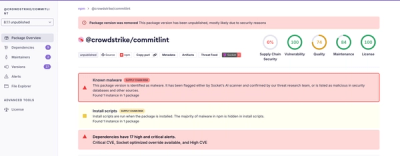
Research
Malicious fezbox npm Package Steals Browser Passwords from Cookies via Innovative QR Code Steganographic Technique
A malicious package uses a QR code as steganography in an innovative technique.
files-pipe
Advanced tools
FilePipe allows you to process files in a pipeline, making it easy to perform
various actions on them.
To get started with FilePipe, follow these steps:
Install the FilePipe package using npm:
npm install -D -E files-pipe
Create a new pipe instance using the following code in your Index.ts file:
Index.ts
await new (await import("files-pipe")).default().In("./Input");
With FilePipe, you can use the Pipe method to perform actions on files within
the pipe. Here's an example of how to use it in your Index.ts:
Index.ts
await(
await(await new (await import("files-pipe")).default().In("./Input")).By(
"**/*.md"
)
).Pipe({
// Append some content to all of the text files
Wrote: (On) => (On.Buffer += "LICENSE [MIT]"),
});
FilePipe provides default callbacks for file processing. These callbacks can
be customized to suit your specific needs. Here are the default callbacks:
await new (await import("files-pipe")).default().Pipe({
// Read the file into a buffer
Read: async ({ Input }) => await fs.promises.readFile(Input, "utf-8"),
// Wrote the buffer into a file
Wrote: async ({ Buffer }) => Buffer,
// Passed the file through a check
Passed: async (On) => On && true,
// Failed processing the file
Failed: async ({ Input }) => `Error: Cannot process file ${Input}!`,
// Accomplished processing the file
Accomplished: async ({ Input, Output }) =>
`Processed ${Input} in ${Output}.`,
// Fulfilled the whole plan
Fulfilled: async ({ File }) =>
`Successfully processed a total of ${File} ${
File === 1 ? "file" : "files"
}.`,
// Changed the plan
Changed: async (Plan) => Plan,
});
You can add multiple paths to your pipe by specifying an array as the Path
variable:
Index.ts
await new (await import("files-pipe")).default().In(["./Input", "./Input2"]);
FilePipe will allow you to provide a map of paths for different input and
output directories, making it easy to control where files are read from and
written to:
Index.ts
await new (await import("files-pipe")).default().In(
new Map([["./Input", "./Output"]])
);
You can filter files to exclude specific ones from your FilePipe. Filters can
be an array of regular expressions or a single match. You can also use functions
to match on file names:
Index.ts
await new (await import("files-pipe")).default().Not([
"File.txt",
(File: string) => File === "./Input/File.txt",
]);
You can control the logging level by setting the Logger parameter. The default
value is 2, but you can set it to 0 if you don't want to see debug messages:
Index.ts
new (await import("files-pipe")).default(0);
See CHANGELOG.md for a history of changes to this component.
FAQs
🧪 File Pipe.
The npm package files-pipe receives a total of 1,844 weekly downloads. As such, files-pipe popularity was classified as popular.
We found that files-pipe demonstrated a not healthy version release cadence and project activity because the last version was released a year ago. It has 1 open source maintainer collaborating on the project.
Did you know?

Socket for GitHub automatically highlights issues in each pull request and monitors the health of all your open source dependencies. Discover the contents of your packages and block harmful activity before you install or update your dependencies.

Research
A malicious package uses a QR code as steganography in an innovative technique.

Research
/Security News
Socket identified 80 fake candidates targeting engineering roles, including suspected North Korean operators, exposing the new reality of hiring as a security function.

Application Security
/Research
/Security News
Socket detected multiple compromised CrowdStrike npm packages, continuing the "Shai-Hulud" supply chain attack that has now impacted nearly 500 packages.